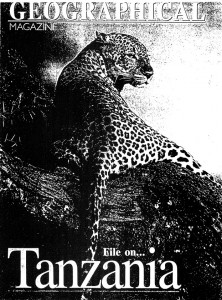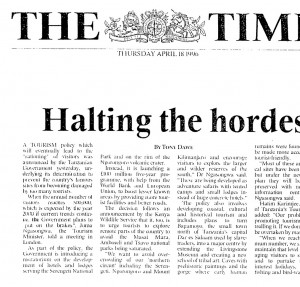A bold new five-year tourism programme involving investment of over $150 million was launched in Britain, at the Royal Geographic Society, on April 17 by Tanzania’s Minister for Natural Resources and Tourism, Dr. Juma Ngasongwa. The meeting coincided with the publication in the Geographic Magazine (May 1996) of an attractively illustrated 16-page Supplement (Cover photograph by Gary J Strand of ‘Wildlife Explorer’) about Tanzania’s tourist attractions. The next day the London Times publicised the event in an article under the heading ‘Halting the Hordes’ – see above.
RATIONING THE NUMBER OF VISITORS
Tourist numbers, which, ten years ago, totalled only 50,000 and have now reached almost 300,000 are to be increased further up to half a million by the year 2000. However, after the year 2,000, a break will be put on further increase in numbers in a bid to create a ‘quality product’ and avoid overcrowding of parks and reserves and hence damage to the fragile ecosystem.
SCOPE AND FUNDING
Funds for the programme are to come from international donors (following completion of a recent ‘World Bank Tourism Infrastructure Plan’ and a ‘European Union Tourism Master Plant plus private sector investments and Government funds. Features of the plan include new roads, upgrading of seven airstrips, the development of a new ‘Southern Circuit’ (Selous – the largest wildlife reserve in the world – Mikumi, Ruaha, Udzungwa, Katavi and Gombe Stream) by construction of tented camps and small lodges rather than big hotels, special interest holidays such as game fishing in the Pemba Channel and Mafia Island, bird watching in the Usambaras, historical tourism (including extension of the Livingstone Museum in Bagamoyo, a new School of Tribal Art there and greater accessibility to the caves with prehistoric paintings and the gorge where early human remains were found.
But critics at the meeting questioned whether it would be possible to control the numbers, One speaker pointed out that Ngorongoro was already catering for 50 vehicles a day and yet a new Sopa Lodge and new Serena Hotel were being built. In Zanzibar hotel construction had “gone berserk”. At a Britain- Tanzania Society tourism seminar held on March 23 one speaker attacked the whole idea of Third World tourism – it led to neo-colonialism, local people did not benefit enough, it destroyed the natural environment, led to prostitution etc. Dr. Ngasongwa, at the Royal Geographic Society, admitted that, as a result of inviting the private sector to develop tourism, there had been overdevelopment but stated that the government was now introducing a moratorium on the development of hotels and lodges serving the Serengeti National Park and the Ngorongoro crater and that all future developments would be subject to environmental impact surveys. Tanzania had learnt by its mistakes. Tanzania Tourist Board Chairman Natim Karimjee added that the main problem he faced was ‘control’. The article went on to say that autonomy would enhance positive management and eliminate the need to depend on governments for subventions.


